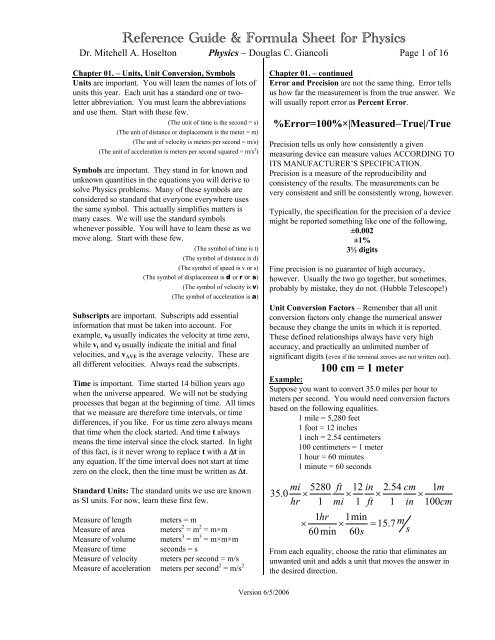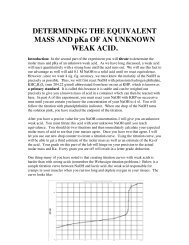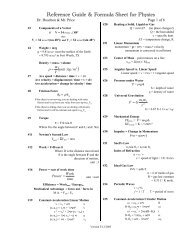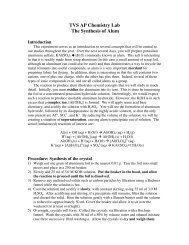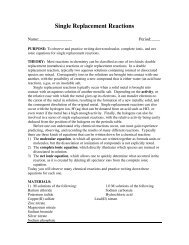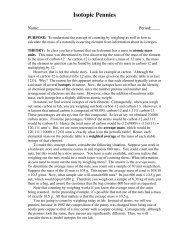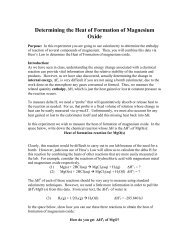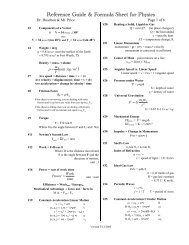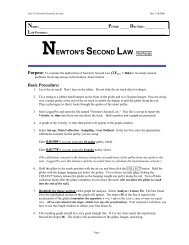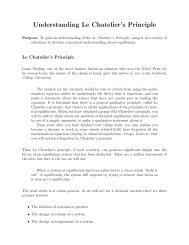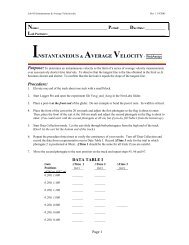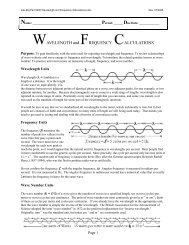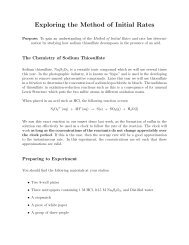Reference Guide & Formula Sheet for Physics - 2006 Version
Reference Guide & Formula Sheet for Physics - 2006 Version
Reference Guide & Formula Sheet for Physics - 2006 Version
Create successful ePaper yourself
Turn your PDF publications into a flip-book with our unique Google optimized e-Paper software.
<strong>Reference</strong> <strong>Guide</strong> & <strong>Formula</strong> <strong>Sheet</strong> <strong>for</strong> <strong>Physics</strong><br />
Dr. Mitchell A. Hoselton <strong>Physics</strong> − Douglas C. Giancoli Page 1 of 16<br />
Chapter 01. – Units, Unit Conversion, Symbols Chapter 01. – continued<br />
Units are important. You will learn the names of lots of<br />
units this year. Each unit has a standard one or twoletter<br />
abbreviation. You must learn the abbreviations<br />
and use them. Start with these few.<br />
(The unit of time is the second = s)<br />
(The unit of distance or displacement is the meter = m)<br />
(The unit of velocity is meters per second = m/s)<br />
(The unit of acceleration is meters per second squared = m/s 2 )<br />
Symbols are important. They stand in <strong>for</strong> known and<br />
unknown quantities in the equations you will derive to<br />
solve <strong>Physics</strong> problems. Many of these symbols are<br />
considered so standard that everyone everywhere uses<br />
the same symbol. This actually simplifies matters is<br />
many cases. We will use the standard symbols<br />
whenever possible. You will have to learn these as we<br />
move along. Start with these few.<br />
(The symbol of time is t)<br />
(The symbol of distance is d)<br />
(The symbol of speed is v or s)<br />
(The symbol of displacement is d or r or s)<br />
(The symbol of velocity is v)<br />
(The symbol of acceleration is a)<br />
Subscripts are important. Subscripts add essential<br />
in<strong>for</strong>mation that must be taken into account. For<br />
example, v 0 usually indicates the velocity at time zero,<br />
while v i and v f usually indicate the initial and final<br />
velocities, and v AVE is the average velocity. These are<br />
all different velocities. Always read the subscripts.<br />
Time is important. Time started 14 billion years ago<br />
when the universe appeared. We will not be studying<br />
processes that began at the beginning of time. All times<br />
that we measure are there<strong>for</strong>e time intervals, or time<br />
differences, if you like. For us time zero always means<br />
that time when the clock started. And time t always<br />
means the time interval since the clock started. In light<br />
of this fact, is it never wrong to replace t with a ∆t in<br />
any equation. If the time interval does not start at time<br />
zero on the clock, then the time must be written as ∆t.<br />
Standard Units: The standard units we use are known mi 5280 ft<br />
35.0 × ×<br />
as SI units. For now, learn these first few.<br />
hr 1 mi<br />
Measure of length meters = m<br />
1hr<br />
× ×<br />
Measure of area meters 2 = m 2 = m×m<br />
60 min<br />
Measure of volume meters 3 = m 3 = m×m×m<br />
Measure of time seconds = s<br />
Measure of velocity meters per second = m/s<br />
Measure of acceleration meters per second 2 = m/s 2<br />
Error and Precision are not the same thing. Error tells<br />
us how far the measurement is from the true answer. We<br />
will usually report error as Percent Error.<br />
%Error=100%×|Measured−True|/True<br />
Precision tells us only how consistently a given<br />
measuring device can measure values ACCORDING TO<br />
ITS MANUFACTURER’S SPECIFICATION.<br />
Precision is a measure of the reproducibility and<br />
consistency of the results. The measurements can be<br />
very consistent and still be consistently wrong, however.<br />
Typically, the specification <strong>for</strong> the precision of a device<br />
might be reported something like one of the following,<br />
±0.002<br />
±1%<br />
3½ digits<br />
Fine precision is no guarantee of high accuracy,<br />
however. Usually the two go together, but sometimes,<br />
probably by mistake, they do not. (Hubble Telescope!)<br />
Unit Conversion Factors – Remember that all unit<br />
conversion factors only change the numerical answer<br />
because they change the units in which it is reported.<br />
These defined relationships always have very high<br />
accuracy, and practically an unlimited number of<br />
significant digits (even if the terminal zeroes are not written out).<br />
100 cm = 1 meter<br />
Example:<br />
Suppose you want to convert 35.0 miles per hour to<br />
meters per second. You would need conversion factors<br />
based on the following equalities.<br />
1 mile = 5,280 feet<br />
1 foot = 12 inches<br />
1 inch = 2.54 centimeters<br />
100 centimeters = 1 meter<br />
1 hour = 60 minutes<br />
1 minute = 60 seconds<br />
12 in 2.54 cm 1m<br />
× ×<br />
1 ft 1 in 100cm<br />
1min<br />
= 15.7 m<br />
60s<br />
s<br />
From each equality, choose the ratio that eliminates an<br />
unwanted unit and adds a unit that moves the answer in<br />
the desired direction.<br />
<strong>Version</strong> 6/5/<strong>2006</strong>
<strong>Reference</strong> <strong>Guide</strong> & <strong>Formula</strong> <strong>Sheet</strong> <strong>for</strong> <strong>Physics</strong><br />
Dr. Mitchell A. Hoselton <strong>Physics</strong> − Douglas C. Giancoli Page 2 of 16<br />
Chapter 02. – Motion Along one Axis<br />
Physical quantities <strong>for</strong> which the direction of their<br />
motion or action is an important characteristic must be<br />
treated mathematically using vectors, not simple<br />
numerical values. Quantities that do not require<br />
directional in<strong>for</strong>mation are called scalars. We begin our<br />
study of vectors by studying motion in one direction.<br />
This type of vector behaves much like a scalar quantity;<br />
only the notation is a little different at this point.<br />
Vectors are symbolized with very bold letters. The<br />
most important quantities in this section are the<br />
instantaneous quantities listed here.<br />
Instantaneous position:<br />
Instantaneous position at time zero: x 0<br />
Instantaneous velocity:<br />
Instantaneous velocity at time zero: v 0<br />
Instantaneous acceleration:<br />
x<br />
v<br />
a<br />
(<strong>for</strong> now, acceleration is assumed to be constant.)<br />
Chapter 02. – continued<br />
With the definition of distance in hand we can define the<br />
scalar quantity known at the average speed.<br />
v AVG = average speed = distance/∆time = d/∆t<br />
Where ∆t is the time interval between the moment when<br />
the object was at the initial position and the moment<br />
when it was at the final position. The time interval is<br />
often writing simply as t, but this is only true if the time<br />
interval begins at the moment when the clock reads zero.<br />
(Think of the clock as a stopwatch.)<br />
With the definition of the displacement in hand we can<br />
define the vector quantity known as the average velocity<br />
v AVG = average velocity = displacement/∆time = d/∆t<br />
Instantaneous Position – x – the position of a moving<br />
object at one moment in time; also known as an instant<br />
of time. Position is always assumed to be instantaneous.<br />
Be<strong>for</strong>e we can rigorously define what we mean by<br />
instantaneous, we need to define some simpler<br />
quantities. The first of these are distance and<br />
displacement. In one dimension these might have the<br />
same numeric value.<br />
d = distance = odometer reading<br />
If the object starts at x 0 and moves back and <strong>for</strong>th<br />
be<strong>for</strong>e settling at its final position, x, then the distance<br />
could be much longer than the shortest path between the<br />
starting and ending points. On the other hand, the<br />
minimum distance is closely related to the displacement.<br />
d MIN = |x − x 0 | = |x 0 − x| = |d|<br />
The minimum distance does not include in<strong>for</strong>mation<br />
about the direction of travel; that is the meaning of those<br />
absolute value markers. The starting and ending<br />
positions are x 0 and x, but the scalar quantity called<br />
“minimum distance” does not care which is which.<br />
Subtraction in either order is permitted.<br />
d = displacement = x − x 0 = d<br />
The vector quantity called “displacement”, on the other<br />
hand, must be calculated as the final position vector<br />
minus the initial position vector. That result always<br />
gives us the minimum distance and the direction of the<br />
motion. For motion along the x-axis, as one example, a<br />
positive displacement indicates motion to the right. A<br />
negative displacement indicates motion to the left.<br />
<strong>Version</strong> 6/5/<strong>2006</strong><br />
Instantaneous Velocity – v – is average velocity over<br />
an infinitesimal displacement in an infinitesimal time<br />
interval. It is the velocity at one instant. As a practical<br />
matter it is usually good enough to measure the average<br />
velocity over a short displacement in a brief time interval<br />
and then take the ratio of those two measurements to<br />
estimate the instantaneous velocity.<br />
Constant-Acceleration Linear Motion<br />
Once our final definitions <strong>for</strong> instantaneous position and<br />
instantaneous velocity are completed, the following<br />
equations of motion apply to all systems that have a<br />
constant acceleration. (When the acceleration is constant, the<br />
instantaneous and average accelerations have the same magnitude and<br />
direction.)<br />
v = v 0 + a•t<br />
no x<br />
(x − x 0 ) = v 0 •t + ½•a•t² no v<br />
v² = v 0 ² + 2•a•(x − x 0 ) no t<br />
(x − x 0 ) = ½•(v 0 + v)•t no a<br />
(x − x 0 ) = v•t − ½•a•t² no v ο<br />
Average velocity can be obtained from the initial and<br />
final instantaneous velocities, if and only if the<br />
acceleration is constant.<br />
v AVE<br />
v + v<br />
=<br />
2<br />
0<br />
=<br />
average velocity
<strong>Reference</strong> <strong>Guide</strong> & <strong>Formula</strong> <strong>Sheet</strong> <strong>for</strong> <strong>Physics</strong><br />
Dr. Mitchell A. Hoselton <strong>Physics</strong> − Douglas C. Giancoli Page 3 of 16<br />
Chapter 02. – continued<br />
Constant Acceleration is rare in nature but common in<br />
the problems we will be working. Constant acceleration<br />
gives the equations of motion their simplest <strong>for</strong>m and<br />
makes them easier to solve. Gravity provides a ready<br />
source of objects moving with constant acceleration.<br />
Strictly speaking, we cannot define average acceleration<br />
until we have a definition <strong>for</strong> instantaneous velocity.<br />
Then the average acceleration is<br />
a AVG = average acceleration<br />
= velocity change/∆time = ∆v/∆t<br />
When the acceleration is constant, the instantaneous and<br />
average acceleration have the same magnitude and<br />
direction. Since the instantaneous acceleration is the<br />
same at all moments, the average acceleration must have<br />
the same magnitude and direction.<br />
One dimensional vectors<br />
To this point, we’ve used only vectors that behave<br />
exactly like signed numerical values, where the sign<br />
indicates the direction along the axis of motion.<br />
Vectors can also be thought of as arrows with pointed<br />
ends showing the direction of the motion. We could<br />
even use these arrows to describe the one-dimensional<br />
vectors discussed in this chapter.<br />
In the next chapter, where objects are free to move in<br />
two dimensions, we will use the arrow representation<br />
first. There is also a method that allows us to reuse the<br />
vector concepts from this chapter; the signed numbers.<br />
We will separate the vectors into what are call their<br />
components. Components are independent onedimensional<br />
sub-sets of the motion.<br />
Chapter 03. –<br />
Components of a Vector and Vector Addition<br />
V = v ∠θ = 34.0 m/s ∠48.0°<br />
v x = v cos θ = 34 m/s•(cos 48°) = 22.8 m/s<br />
v y = v sin θ = 34 m/s•(sin 48°) = 25.3 m/s<br />
V = v x i + v y j = 22.8 i + 25.3 j m/s<br />
W = w ∠θ = 52.0 m/s ∠113.0°<br />
w x = w cos θ = 52 m/s•(cos 113°) = −20.3 m/s<br />
w y = w sin θ = 52 m/s•(sin 113°) = 47.9 m/s<br />
w = w x i + w y j = −20.3 i + 47.9 j m/s<br />
Chapter 03. – continued<br />
V + w = (22.8−20.3) i + (25.3+47.9) j m/s<br />
V + w = 2.5 i + 73.2 j m/s = w + V<br />
V − w = (22.8−(−20.3)) i + (25.3−47.9) j m/s<br />
= 43.1 i − 22.6 j m/s<br />
w − V = (−20.3−22.8) i + (47.9−25.3) j m/s<br />
= −43.1 i + 22.6 j m/s<br />
V − w and w − V, point in opposite directions and<br />
both are perpendicular to V + w = w + V.<br />
Projectile Motion – working with components<br />
Horizontal position: x−x ο = v x •t<br />
Vertical position: y−y ο = v y0 •t − ½•g•t²<br />
Horizontal velocity: v x = v 0 cos θ<br />
Vertical velocity: v y = v 0 sin θ – gt 2<br />
Horizontal acceleration: a x = 0<br />
Vertical acceleration: a y = −g = constant<br />
Chapter 04. –<br />
Newton’s First Law – Law of Inertia. Forces make<br />
objects move. No <strong>for</strong>ce means no change in the motion.<br />
Newton's Second Law – Forces cause acceleration.<br />
F net<br />
= ΣF Ext = m sys •a sys<br />
Newton’s Third Law – Forces are created in pairs.<br />
Weight = W = m•g<br />
g = 9.80m/s² near the surface of the Earth<br />
= 9.795 m/s² in Fort Worth, TX<br />
Friction Force = F F = µ•F N<br />
If the object is not moving, you are dealing with static<br />
friction and it can have any value from zero up to µ S<br />
F N<br />
If the object is sliding, then you are dealing with kinetic<br />
friction and it will be constant and equal to µ K<br />
F N<br />
Free-Body Diagram – Show all the <strong>for</strong>ces acting on and<br />
object. Components must be dashed to distinguish them<br />
from <strong>for</strong>ces. You cannot use a <strong>for</strong>ce and its components<br />
in the same problem.<br />
<strong>Version</strong> 6/5/<strong>2006</strong>
<strong>Reference</strong> <strong>Guide</strong> & <strong>Formula</strong> <strong>Sheet</strong> <strong>for</strong> <strong>Physics</strong><br />
Dr. Mitchell A. Hoselton <strong>Physics</strong> − Douglas C. Giancoli Page 4 of 16<br />
Chapter 05. –<br />
Uni<strong>for</strong>m Circular Motion - Centripetal Acceleration<br />
Uni<strong>for</strong>m Circular Motion – Period, Frequency and V<br />
T<br />
1<br />
=<br />
f<br />
Centripetal Force<br />
Minimum Speed at the top of a Vertical Loop<br />
rg v =<br />
Circular Unbanked Track – Car Rounding a Curve.<br />
2<br />
mv<br />
F = µ mg = =<br />
r<br />
C<br />
ma R<br />
Banked Circular Track<br />
v 2 = r•g•tan θ, without friction<br />
Universal Gravitation – Conservative Force<br />
m m<br />
F = G<br />
r<br />
1 2<br />
2<br />
where G = 6.67 ×10 −11 N•m² / kg² = 6.67 E−11 N•m² / kg²<br />
Chapter 06. –<br />
and<br />
v<br />
=<br />
r<br />
a R<br />
2<br />
f<br />
mv<br />
r<br />
1<br />
=<br />
T<br />
and v =<br />
2<br />
2<br />
F C<br />
=<br />
= mω<br />
r<br />
2πr<br />
T<br />
Work done by a constant <strong>for</strong>ce = F•D•cos θ<br />
Where D is the displacement of the mass and<br />
θ is the angle between F and D. unit : N•m = J<br />
Work done by a varying <strong>for</strong>ce<br />
On a graph of Force vs displacement the work is the<br />
area between the curve and the x-axis. Later on we<br />
will evaluate this are by taking the anti-derivative of<br />
the function that describes the <strong>for</strong>ce in terms of<br />
position.<br />
Mechanical Energy –Kinetic Energy<br />
KE Linear = K = ½•m•v²<br />
Chapter 06 – continued<br />
Mechanical Energy – The Work-Energy Theorem<br />
The net work done on a body equals the change in<br />
the kinetic energy of the body.<br />
W net = ∆KE = KE f − KE i<br />
= ½•m•v f ² − ½•m•v i ²<br />
Mechanical Energy – Gravitational Potential Energy<br />
PE Grav = PE g = m•g•h<br />
= m•g•y<br />
Hooke's Law – a non-constant <strong>for</strong>ce<br />
F = −k•x<br />
x = displacement from equilibrium<br />
k = the spring constant<br />
= proportionality constant between<br />
the restoring <strong>for</strong>ce and the<br />
displacement.<br />
Potential Energy of a spring – Conservative Force<br />
Work done on a spring = PE = W = ½•k•x²<br />
Power = rate of work done, unit = J/s = W = watts<br />
Work Fd<br />
average power = P = = = Fv<br />
∆time<br />
∆t<br />
Chapter 07. –<br />
Linear Momentum<br />
momentum = p = m•v = mass • velocity<br />
Newton's Second Law<br />
F<br />
= ΣF<br />
∆p<br />
mv − mv<br />
= =<br />
∆t<br />
∆t<br />
m( v − v )<br />
0<br />
=<br />
∆t<br />
0<br />
=<br />
net Ext<br />
Impulse = Change in Momentum<br />
F•∆t = ∆p = ∆(m•v)<br />
ma<br />
Conservation of Momentum in Collisions<br />
m A •v A + m B •v B = m A •v A ’ + m B •v B ’<br />
Sum of Momenta be<strong>for</strong>e the Collision<br />
Sum of Momenta after the Collision<br />
Center of Mass – point masses on a line (x only), on a<br />
plane (x and y only), or filling space (x, y, and z)<br />
x cm = Σ(m i •x i ) / M total<br />
y cm = Σ(m i •y i ) / M total<br />
z cm = Σ(m i •z i ) / M total<br />
<strong>Version</strong> 6/5/<strong>2006</strong>
<strong>Reference</strong> <strong>Guide</strong> & <strong>Formula</strong> <strong>Sheet</strong> <strong>for</strong> <strong>Physics</strong><br />
Dr. Mitchell A. Hoselton <strong>Physics</strong> − Douglas C. Giancoli Page 5 of 16<br />
Chapter 08. –<br />
Angular Distance – Radian measure<br />
θ = arc length/radius = l/r = s / r<br />
360º = 2π radians<br />
Angular Speed vs. Linear Speed<br />
Linear speed = v = r•ω = radius • angular speed<br />
Constant Angular-Acceleration in Circular Motion<br />
ω = ω ο + α•t<br />
no θ<br />
θ−θ ο = ω ο •t + ½•α•t² no ω<br />
ω 2 2<br />
= ω ο + 2•α•(θ−θο ) no t<br />
θ−θ ο = ½•(ω ο + ω)•t no α<br />
θ−θ ο = ω•t - ½•α•t² no ω ο<br />
Torque = τ = F•L•sin θ<br />
Where θ is the angle between F and L; unit: N•m<br />
Chapter 09. –<br />
Elasticity; Stress and Strain<br />
(Assumes objects stretch according to Hooke’s Law as long as<br />
they<br />
are not stretched passed the proportional limit.)<br />
For tensile stress<br />
F = k•∆L = (EA/L 0 )•∆L<br />
F = applied <strong>for</strong>ce<br />
E = elastic (or Young’s) modulus<br />
A = cross-sectional area –<br />
perpendicular to the <strong>for</strong>ce<br />
L 0 = the original length<br />
∆L = change in the length<br />
∆L/L 0 = (1/E)•(F/A)<br />
strain = (1/E)•(stress)<br />
E = (stress / strain)<br />
Newton's Second Law <strong>for</strong> Rotation<br />
torque = τ = I•α<br />
moment of inertia = I CM = m•r² (<strong>for</strong> a point mass)<br />
Rotational Kinetic Energy (See LEM on last page)<br />
KE rotational = ½•I•ω 2 = ½•I• (v / r) 2<br />
KE rolling w/o slipping = ½•m•v 2 + ½•I•ω 2<br />
Moment of Inertia – I CM<br />
point mass I CM = m•r 2<br />
cylindrical hoop I CM = m•r 2<br />
solid cylinder or disk I CM = ½ m•r 2<br />
solid sphere I CM = 2 / 5 m•r 2<br />
hollow sphere I CM = ⅔ m•r 2<br />
thin rod (center) I CM = 1 / 12 m•L 2<br />
When the thin rod is rotated about its end rather than<br />
about is center of mass, the moment of inertia becomes<br />
thin rod (end) I End = ⅓ m•L 2<br />
Angular Momentum = L = I•ω = m•v•r•sin θ<br />
Angular Impulse equals CHANGE IN Angular<br />
Momentum<br />
∆L = τ Average •∆t = ∆(I•ω)<br />
Compressive stress is the exact opposite of tensile<br />
stress. Objects are compressed rather than<br />
stretched. As <strong>for</strong> springs the equations are the same<br />
<strong>for</strong> both tensile and compressive stress and the same<br />
elastic modulus is used <strong>for</strong> both calculations.<br />
∆L/L 0 = −(1/E)•(F/A)<br />
strain = − (1/E)•(stress)<br />
E = − (stress / strain)<br />
There is a negative sign because the length<br />
decreases as the <strong>for</strong>ce increases (∆L is negative).<br />
Shear stress is the application of two <strong>for</strong>ces that distort<br />
an object (like de<strong>for</strong>ming a rectangle into a parallelogram).<br />
The <strong>for</strong>ces are equal and opposite (parallel, but not<br />
oriented to directly oppose each other). (A second pair of<br />
matched <strong>for</strong>ces is also required to maintain equilibrium while the<br />
stress is applied.)<br />
∆L /L 0 = (1/G)•(F/A)<br />
strain = (1/G)•(stress)<br />
G = (stress / strain)<br />
G = shear modulus<br />
A = area – Parallel to the <strong>for</strong>ce.<br />
L 0 = original length of object<br />
∆L = change in length due to <strong>for</strong>ce<br />
Note that ∆L is perpendicular to L 0 .<br />
<strong>Version</strong> 6/5/<strong>2006</strong>
<strong>Reference</strong> <strong>Guide</strong> & <strong>Formula</strong> <strong>Sheet</strong> <strong>for</strong> <strong>Physics</strong><br />
Dr. Mitchell A. Hoselton <strong>Physics</strong> − Douglas C. Giancoli Page 6 of 16<br />
Chapter 09. – continued<br />
Bulk Stress - When the <strong>for</strong>ce is applied uni<strong>for</strong>mly all<br />
over an object, we expect its volume to shrink. When<br />
applied this way, the ratio of <strong>for</strong>ce to area is called<br />
“pressure”, and ∆P is the change in pressure that induces<br />
a corresponding change in the volume.<br />
∆V/V 0 = −(1/B)•(∆P)<br />
strain = −(1/B)•(stress)<br />
B = −(stress / strain)<br />
B = bulk modulus<br />
V 0 = initial volume of the material<br />
∆V = Change in the volume<br />
∆P = change in pressure<br />
The minus sign indicates that the volume decreases<br />
when the pressure increases. When ∆P is positive, ∆V is<br />
negative, and vice versa. One of the two is always<br />
negative.<br />
Chapter 10. –<br />
Pressure under Water (or immersed in any liquid)<br />
P = ρ•g•h<br />
Density = mass / volume<br />
ρ =<br />
P = Pressure at depth<br />
h = depth below the surface<br />
ρ = density of the fluid<br />
m<br />
V<br />
3<br />
( unit : kg / m )<br />
Buoyant Force - Buoyancy<br />
F B = ρ•V•g<br />
= m Displaced fluid •g<br />
= weight Displaced fluid<br />
ρ = density of the fluid<br />
V = volume of fluid displaced<br />
Continuity of Fluid Flow<br />
Q Volume Flow Rate = A in •v in = A out •v out<br />
A = Cross-sectional Area<br />
v = velocity of the fluid<br />
Chapter 10. – continued<br />
Poiseuille's Equation (Laminar flow in horizontal tubular pipes.)<br />
Q = volume flow rate of fluid = m 3 /s<br />
Q = (π•r 4 ) ∆P / (8•η•L)<br />
r = inside radius of pipe = m<br />
∆P = P 1 – P 2 = Pressure change = Pa<br />
η = coefficient of viscosity = Pa•s<br />
L = length of pipe = m<br />
Bernoulli's Equation<br />
P + ρ•g•h + ½•ρ•v ² = constant<br />
Q Volume Flow Rate = A 1 •v 1 = A 2 •v 2 = constant<br />
Chapter 11. –<br />
Period of Simple Harmonic Motion – Ideal Spring<br />
also f = 1/ T<br />
where k = spring constant, and m is the mass.<br />
Simple Pendulum<br />
T =<br />
2π<br />
T = 2π<br />
also f = 1/ T<br />
where L is the length of the pendulum and g is<br />
the local acceleration due to gravity.<br />
Velocity of Periodic Waves<br />
f = 1 / T<br />
v = f •λ = λ/Τ<br />
where T = the period of the wave<br />
Speed of a Wave on a String<br />
L<br />
g<br />
m<br />
k<br />
mv 2<br />
T = ; there<strong>for</strong>e, v =<br />
L<br />
T<br />
m/L<br />
T = tension in string<br />
m = mass of string<br />
L = length of string<br />
Sinusoidal motion<br />
x = A•cos(ω•t) = A•cos(2•π•f •t)<br />
ω = angular frequency<br />
f = frequency<br />
<strong>Version</strong> 6/5/<strong>2006</strong>
<strong>Reference</strong> <strong>Guide</strong> & <strong>Formula</strong> <strong>Sheet</strong> <strong>for</strong> <strong>Physics</strong><br />
Dr. Mitchell A. Hoselton <strong>Physics</strong> − Douglas C. Giancoli Page 7 of 16<br />
Chapter 12. –<br />
Doppler Effect<br />
f<br />
v o<br />
= velocity of observer:<br />
v s<br />
= velocity of source<br />
v SOUND = 343 m/s<br />
Decibel Scale<br />
dB (Decibel level) = 10 log ( I / I o<br />
)<br />
I = intensity of sound<br />
I o<br />
= intensity of softest audible sound<br />
Chapter 13. –<br />
Ideal Gas Law<br />
′ =<br />
Toward<br />
Away<br />
Toward<br />
Away<br />
P•V = n•R•T<br />
n = # of moles of gas<br />
R = gas law constant<br />
= 8.31 J/mol•K.<br />
Thermal Expansion of Solids<br />
Linear: ∆L = L o<br />
•α•∆T<br />
Volume: ∆V = V o<br />
•β•∆T<br />
Chapter 14. –<br />
Heating a Solid, Liquid or Gas<br />
Q = m•c•∆T<br />
f<br />
343 ±<br />
343<br />
m<br />
v<br />
v<br />
(no phase changes!)<br />
Q = the heat added<br />
c = specific heat.<br />
∆T = temperature change, K or ºC<br />
o<br />
s<br />
Chapter 15. –<br />
First Law of Thermodynamics<br />
∆U = Q Net + W Net<br />
Change in Internal Energy of a system =<br />
+Net Heat added to the system<br />
+Net Work done on the system<br />
Work done on a gas or by a gas<br />
W = P•∆V<br />
2 nd Law of Thermodynamics<br />
The change in internal energy of a system is<br />
∆U = Q Added + W DoneOn – Q lost – W DoneBy<br />
Maximum Efficiency of a Heat Engine (Carnot Cycle)<br />
Tc<br />
% Eff = (1 − ) ⋅100%<br />
T<br />
Efficiency = Work out / Energy in<br />
(Temperatures in Kelvin)<br />
Mechanical Advantage = <strong>for</strong>ce out / <strong>for</strong>ce in<br />
M.A. = F out / F in<br />
Entropy change at constant T<br />
∆S = Q / T<br />
(Applies to phase changes only: melting, boiling, freezing, etc)<br />
Chapter 16. –<br />
Coulomb's Law<br />
h<br />
F = k<br />
k = = 8.85×<br />
10<br />
4πε<br />
q<br />
1 + 9<br />
o<br />
1 2<br />
2<br />
r<br />
q<br />
N ⋅ m<br />
2<br />
C<br />
2<br />
N ⋅ m<br />
≈ 9E9<br />
2<br />
C<br />
2<br />
Heat required <strong>for</strong> a Phase Change<br />
Q = m•L<br />
m = mass of material<br />
L = Latent Heat of phase change<br />
Flow of Heat through a Solid<br />
∆Q / ∆t = k•A•∆T / L<br />
k = thermal conductivity<br />
A = area of solid<br />
∆T = Temperature difference<br />
L = thickness of solid<br />
Electric Field around a point charge<br />
E = k<br />
1 + 9<br />
k = = 8.85×<br />
10<br />
4πε<br />
o<br />
r<br />
q<br />
2<br />
N ⋅ m<br />
2<br />
C<br />
2<br />
N ⋅ m<br />
≈ 9E9<br />
2<br />
C<br />
2<br />
<strong>Version</strong> 6/5/<strong>2006</strong>
<strong>Reference</strong> <strong>Guide</strong> & <strong>Formula</strong> <strong>Sheet</strong> <strong>for</strong> <strong>Physics</strong><br />
Dr. Mitchell A. Hoselton <strong>Physics</strong> − Douglas C. Giancoli Page 8 of 16<br />
Chapter 17. –<br />
Capacitors and Capacitance<br />
Q c = C•V c<br />
Q c = charge on capacitor<br />
(The unit of electric charge is the coulomb = C)<br />
C = capacitance of the capacitor<br />
(The unit of capacitance is the farad = F = C/V)<br />
V c = voltage across the plates<br />
(The unit of voltage is the volt = V = J/C)<br />
Chapter 19. –<br />
Resistor Combinations<br />
SERIES<br />
R eq = R 1 + R 2 + R 3 +. . .<br />
1<br />
R<br />
eq<br />
=<br />
1<br />
R<br />
1<br />
+<br />
1<br />
R<br />
PARALLEL<br />
2<br />
+ K +<br />
1<br />
R<br />
n<br />
=<br />
n<br />
∑<br />
i=<br />
1<br />
1<br />
R<br />
i<br />
Potential Energy stored in a Capacitor<br />
P = ½•C•V²<br />
Chapter 18. –<br />
Ohm's Law<br />
V = I•R<br />
V = voltage across the resistor<br />
(The unit of voltage is the volt = V = J/C)<br />
I = current through the resistor<br />
(The unit of current is the ampere = A = C/s)<br />
R = resistance of the resistor<br />
(The unit of resistance is the ohm = Ω = V/A)<br />
Resistance of a resistor (or any resistive material)<br />
R = ρ•L / A x<br />
ρ = resistivity of the material<br />
(The unit of resistivity is the ohm•meter = Ω•m)<br />
L = length of the material<br />
(The unit of length is the meter = m)<br />
A x = cross-sectional area of the<br />
Material or resistor<br />
(The unit of cross-sectional area is meter 2 = m 2 )<br />
Electric Power (The unit of power is the watt = W = J/s)<br />
P = I²•R<br />
P = V ² / R<br />
P = I•V<br />
Capacitor Combinations<br />
SERIES<br />
1<br />
=<br />
1<br />
Kirchhoff’s Laws<br />
1<br />
+<br />
C<br />
1<br />
+ K +<br />
C<br />
PARALLEL<br />
C eq = C 1 + C 2 + C 3 + …<br />
Node Rule: Σ node I i = 0<br />
Loop Rule: Σ loop ∆V i = 0<br />
Capacitance, C, of a Capacitor<br />
C = κ•εo•A / d<br />
n 1<br />
= ∑<br />
i =<br />
C<br />
1<br />
C C<br />
eq<br />
1<br />
2<br />
n<br />
κ = dielectric constant<br />
A = area of plates<br />
d = distance between plates<br />
ε o<br />
= 8.85 10 −12 ) F/m<br />
(Capital “C” is also used as the abbreviation <strong>for</strong> the unit of electric<br />
charge; the coulomb = C. Do not confuse the two uses of capital “C”.<br />
The unit of capacitance is the farad = F. The capital “F” is frequently<br />
used as the symbol <strong>for</strong> <strong>for</strong>ce. Do not confuse the two used of the<br />
capital “F”.)<br />
RC Circuit <strong>for</strong>mula (Charging with one battery, one<br />
resistor and one capacitor)<br />
V Battery<br />
− V capacitor − I•R = 0<br />
RC Circuits (Charging) - R•C = τ = time constant<br />
V c = V MAX •[1 - e −t/RC ]<br />
But V c − I•R = 0 (from Ohm’s Law), there<strong>for</strong>e,<br />
I = (V MAX /R)•e −t/RC<br />
= I MAX•e −t/RC<br />
And Q c = CV c (from the definition of capacitance), so<br />
Q c = C•V MAX •[1 − e −t/RC ]<br />
= Q MAX •[1 − e −t/RC ]<br />
i<br />
<strong>Version</strong> 6/5/<strong>2006</strong>
<strong>Reference</strong> <strong>Guide</strong> & <strong>Formula</strong> <strong>Sheet</strong> <strong>for</strong> <strong>Physics</strong><br />
Dr. Mitchell A. Hoselton <strong>Physics</strong> − Douglas C. Giancoli Page 9 of 16<br />
Chapter 19. – continued<br />
RC Circuits (Discharging) - R•C = τ = time constant<br />
V c = V MAX •e −t/RC<br />
But V c − I•R = 0 (from Ohm’s Law), there<strong>for</strong>e,<br />
I = (V MAX /R)•e −t/RC<br />
= I MAX•e −t/RC<br />
And Q c = CV c (from the definition of capacitance), so<br />
Q c =C•V MAX •e −t/RC<br />
=Q MAX •e −t/RC<br />
Chapter 20. –<br />
Magnetic Field around a wire<br />
Magnetic Flux<br />
B<br />
Φ = B•A•cos θ<br />
Force caused by a magnetic field acting on a<br />
moving charge<br />
F = q•v•B•sin θ<br />
Chapter 21. –<br />
Induced Voltage<br />
Emf<br />
µ<br />
o<br />
I<br />
=<br />
2πr<br />
∆Φ<br />
= N<br />
∆t<br />
N = # of loops<br />
Lenz’s Law – induced current flows to create a B-field<br />
opposing the change in magnetic flux.<br />
Inductors during an increase in current<br />
− t / (L / R)<br />
V L<br />
= V cell<br />
•e<br />
I = (V cell<br />
/R)•[ 1 - e − t / (L / R) ]<br />
L / R = time constant<br />
Trans<strong>for</strong>mers<br />
N 1<br />
/ N<br />
2 = V 1 / V 2<br />
I 1<br />
•V 1<br />
= I2•V2<br />
Chapter 22. –<br />
Energy of a Photon or a Particle<br />
E = h•f = m•c 2<br />
Chapter 23. –<br />
Snell's Law<br />
h = Planck's constant<br />
= 6.63 × 10 −34 J•s<br />
f = frequency of the photon<br />
n 1 •sin θ 1 = n 2 •sin θ 2<br />
Index of Refraction - definition<br />
n = c / v<br />
c = speed of light in a vacuum<br />
= 3 × 10 +8 m/s = 3 E+8 m/s<br />
v = speed of light in the medium<br />
= less than 3 × 10 +8 m/s<br />
Thin Lens Equation<br />
1<br />
f<br />
1<br />
=<br />
d<br />
f = focal length<br />
i = image distance<br />
o = object distance<br />
Magnification Equation<br />
M = −d i / d o = −i / o = H i / H o<br />
Helpful reminders <strong>for</strong> mirrors and lenses<br />
Focal Length of: positive negative<br />
mirror concave convex<br />
lens converging diverging<br />
Object distance = o all objects<br />
Object height = H o all objects<br />
Image distance = i real virtual<br />
Image height = H i virtual, upright real, inverted<br />
Magnification virtual, upright real, inverted<br />
Chapter 24. –<br />
Chapter 25. –<br />
o<br />
1<br />
+<br />
d<br />
i<br />
1 1<br />
= +<br />
o i<br />
<strong>Version</strong> 6/5/<strong>2006</strong>
<strong>Reference</strong> <strong>Guide</strong> & <strong>Formula</strong> <strong>Sheet</strong> <strong>for</strong> <strong>Physics</strong><br />
Dr. Mitchell A. Hoselton <strong>Physics</strong> − Douglas C. Giancoli Page 10 of 16<br />
Chapter 26. –<br />
The Lorentz trans<strong>for</strong>mation factor, β, is given by<br />
β =<br />
2<br />
v<br />
1−<br />
c<br />
Relativistic Time Dilation<br />
∆t = ∆t o<br />
/ β<br />
Relativistic Length Contraction<br />
∆x = β•∆x o<br />
Relativistic Mass Increase<br />
It is usually expressed in terms of the momentum of<br />
the object<br />
p = m v •v = m o<br />
•v / β<br />
where β is the Lorentz trans<strong>for</strong>mation factor.<br />
Mass-Energy Equivalence<br />
m v = m o / β<br />
Total Energy = KE + m o c 2 = m o c 2 / β<br />
Usually written as E = m c 2<br />
Postulates of Special Relativity<br />
1. The laws of <strong>Physics</strong> have the same <strong>for</strong>m<br />
in all inertial reference frames.<br />
(Absolute, uni<strong>for</strong>m motion cannot be detected by<br />
examining the equations of motion.)<br />
2. Light propagates through empty space<br />
with a definite speed, c, independent of<br />
the speed of the source or the observer.<br />
(No energy or mass transfer can occur at speeds faster<br />
than the speed of light in a vacuum.)<br />
2<br />
Chapter 27. –<br />
Blackbody Radiation and the Photoelectric Effect<br />
E= h•f<br />
h = Planck's constant<br />
Early Quantum <strong>Physics</strong><br />
Ruther<strong>for</strong>d-Bohr Hydrogen-like Atoms<br />
f<br />
⎛ 1 1 ⎞<br />
1<br />
= R ⋅<br />
⎜ −<br />
2 2<br />
⎟meters<br />
⎝ ns<br />
n ⎠<br />
or<br />
c ⎛ 1 1 ⎞<br />
= = cR⎜<br />
⎟<br />
− Hz<br />
2 2<br />
λ n<br />
s<br />
n<br />
⎝ ⎠<br />
R = Rydberg's Constant<br />
= 1.097373143 E7 m -1<br />
n s = series integer (2 = Balmer Series)<br />
n = an integer > n s<br />
de Broglie Matter Waves<br />
For light:<br />
E p = h•f = h•c / λ = p•c<br />
There<strong>for</strong>e:<br />
p = h / λ<br />
By analogy, <strong>for</strong> particles, we expect to find that<br />
p = m•v = h / λ,<br />
Thus, matter’s wavelength should be<br />
Chapter 28. –<br />
1 −<br />
λ<br />
λ = h / m v<br />
Chapter 29. –<br />
Energy Released or Consumed by a Nuclear Fission<br />
or Nuclear Fusion Reaction<br />
E = ∆m•c 2<br />
Where ∆m is the difference between the sum of the<br />
masses of all the reactants and the sum of the<br />
masses of all the products.<br />
<strong>Version</strong> 6/5/<strong>2006</strong>
<strong>Reference</strong> <strong>Guide</strong> & <strong>Formula</strong> <strong>Sheet</strong> <strong>for</strong> <strong>Physics</strong><br />
Dr. Mitchell A. Hoselton <strong>Physics</strong> − Douglas C. Giancoli Page 11 of 16<br />
Chapter 30. –<br />
Radioactive Decay Rate Law<br />
N = No•e −k t = (1/2 n )•N 0<br />
Chapter 31. –<br />
Chapter 32. –<br />
Chapter 33. –<br />
Appendix A –<br />
Appendix B –<br />
Appendix C –<br />
Appendix D –<br />
A = Ao•e −k t = (1/2 n )•A 0<br />
k = (ln 2) / half-life<br />
N 0 = initial number of atoms<br />
A 0 = initial activity<br />
n = number of half-lives<br />
Appendix E –<br />
Lorentz Trans<strong>for</strong>mation Factor<br />
Appendix F –<br />
Appendix G –<br />
Appendix H –<br />
Appendix I –<br />
Appendix J –<br />
β =<br />
1<br />
c<br />
v<br />
−<br />
2<br />
2<br />
<strong>Version</strong> 6/5/<strong>2006</strong>
<strong>Reference</strong> <strong>Guide</strong> & <strong>Formula</strong> <strong>Sheet</strong> <strong>for</strong> <strong>Physics</strong><br />
Dr. Mitchell A. Hoselton <strong>Physics</strong> − Douglas C. Giancoli Page 12 of 16<br />
MISCELLANEOUS FORMULAS<br />
Quadratic <strong>Formula</strong><br />
if a·x²+ b·x + c = 0<br />
− b ±<br />
x =<br />
then<br />
b<br />
2 − 4ac<br />
2a<br />
Trigonometric Definitions<br />
sin θ = opposite / hypotenuse<br />
cos θ = adjacent / hypotenuse<br />
tan θ = opposite / adjacent<br />
sec θ = 1 / cos θ = hyp / adj<br />
csc θ = 1 / sin θ = hyp / opp<br />
cot θ = 1 / tan θ = adj / opp<br />
Inverse Trigonometric Definitions<br />
θ = sin -1 (opp / hyp)<br />
θ = cos -1 (adj / hyp)<br />
θ = tan -1 (opp / adj)<br />
Law of Sines<br />
a / sin A = b / sin B = c / sin C<br />
or<br />
sin A / a = sin B / b = sin C / c<br />
Law of Cosines<br />
a 2 = b 2 + c 2 - 2 b c cos A<br />
b 2 = c 2 + a 2 - 2 c a cos B<br />
c² = a² + b² - 2 a b cos C<br />
Trigonometric Identities<br />
sin 2 θ + cos 2 θ = 1<br />
sin 2θ = 2 sin θ cos θ<br />
tan θ = sin θ / cos θ<br />
sin (θ + 180º) = −sin θ<br />
cos (θ + 180º) = −cos θ<br />
sin (180º − θ) = sin θ<br />
cos (180º − θ) = −cos θ<br />
sin (90º − θ) = cos θ<br />
cos (90º − θ) = sin θ<br />
Fundamental SI Units<br />
Unit Base Unit Symbol<br />
…………………….<br />
Length meter m<br />
Mass kilogram kg<br />
Time second s<br />
Electric<br />
Current ampere A<br />
Thermodynamic<br />
Temperature kelvin K<br />
Luminous<br />
Intensity candela cd<br />
Quantity of<br />
Substance moles mol<br />
Plane Angle radian rad<br />
Solid Angle steradian sr or str<br />
Some Derived SI Units<br />
Symbol/Unit Quantity Base Units<br />
…………………….<br />
C coulomb Electric Charge A·s<br />
F farad Capacitance A 2·s 4 /(kg·m 2 )<br />
H henry Inductance kg·m 2 /(A 2·s 2 )<br />
Hz hertz Frequency s -1<br />
J joule Energy & Work kg·m 2 /s 2 = N·m<br />
N newton Force kg·m/s 2<br />
Ω ohm Elec Resistance kg·m 2 /(A 2·s 2 )<br />
Pa pascal Pressure kg/(m·s 2 )<br />
T tesla Magnetic Field kg/(A·s 2 )<br />
V volt Elec Potential kg·m 2 /(A·s 2 )<br />
W watt Power kg·m 2 /s 3<br />
Non-SI Units<br />
o C degree Celsius Temperature<br />
eV electron-volt Energy, Work<br />
<strong>Version</strong> 6/5/<strong>2006</strong>
<strong>Reference</strong> <strong>Guide</strong> & <strong>Formula</strong> <strong>Sheet</strong> <strong>for</strong> <strong>Physics</strong><br />
Dr. Mitchell A. Hoselton <strong>Physics</strong> − Douglas C. Giancoli Page 13 of 16<br />
Latin Symbols <strong>for</strong> Quantities and Units<br />
Aa acceleration, Area, A x =Cross-sectional Area,<br />
Amperes, Amplitude of a Wave, Angle,<br />
Bb Magnetic Field, Bel (sound intensity), Angle,<br />
Cc specific heat, speed of light, Capacitance, Angle,<br />
Coulomb, o C=degrees Celsius, candela,<br />
Dd displacement, differential change in a variable,<br />
Distance, Distance Moved, degrees, o F, o C,<br />
Ee base of the natural logarithms, charge on the<br />
electron, eV=electron volt, Energy,<br />
Ff Force, frequency of a wave or periodic motion,<br />
Farad, o F=degrees Fahrenheit,<br />
Gg Universal Gravitational Constant, acceleration<br />
due to gravity, Gauss, grams, Giga-,<br />
Hh depth of a fluid, height, vertical distance,<br />
Henry, Hz=Hertz,<br />
Ii Current, Moment of Inertia, image distance,<br />
Intensity of Light or Sound,<br />
Jj Joule,<br />
Kk K or KE = Kinetic Energy, <strong>for</strong>ce constant of a<br />
spring, thermal conductivity, coulomb'slaw<br />
constant, kg=kilogram, Kelvin, kilo-, rate<br />
constant <strong>for</strong> Radioactive decay =1/τ=ln2 / halflife,<br />
Ll Length, Length of a wire, Latent Heat of Fusion or<br />
Vaporization, Angular Momentum, Thickness,<br />
Inductance,<br />
Mm mass, Total Mass, meter, milli-, Mega-,<br />
m o =rest mass, mol=moles,<br />
Nn index of refraction, moles of a gas, Newton,<br />
Number of Loops, nano-, Newton·meter,<br />
Oo Ohm(Ω),<br />
Pp Power, Pressure of a Gas or Fluid, Potential Energy,<br />
momentum, Pa=Pascal,<br />
Qq Heat gained or lost, Charge on a capacitor, charge<br />
on a particle, object distance, Flow Rate,<br />
Rr radius, Ideal Gas Law Constant, Resistance,<br />
magnitude or length of a vector, rad=radians,<br />
Ss speed, second, Entropy, length along an arc,<br />
Tt time, Temperature, Period of a Wave, Tension,<br />
Tesla, t 1/2 =half-life,<br />
Uu Potential Energy,<br />
Vv velocity, Velocity, Volume of a Gas, velocity of<br />
wave, Volume of Fluid Displaced, Voltage,<br />
Volt,<br />
Ww weight, Work, Watt, Wb=Weber,<br />
Xx distance, horizontal distance, x-coordinate<br />
east-and-west coordinate,<br />
Yy vertical distance, y-coordinate,<br />
north-and-south coordinate,<br />
Zz z-coordinate, up-and-down coordinate,<br />
Greek Symbols <strong>for</strong> Quantities and Units<br />
a-Αα Alpha angular acceleration, coefficient of<br />
linear expansion,<br />
b-Ββ Beta coefficient of volume expansion,<br />
lorentz trans<strong>for</strong>mation factor,<br />
c-Χχ Chi<br />
d-∆δ Delta ∆=Change in a variable,<br />
e-Εε Epsilon ε ο = permittivity of free space,<br />
f-Φφϕ(j) Phi Magnetic Flux, angle,<br />
g-Γγ Gamma surface tension = F / L,<br />
1 / γ = Lorentz trans<strong>for</strong>mation factor,<br />
h-Ηη Eta<br />
i-Ιι Iota<br />
k-Κκ Kappa dielectric constant,<br />
l-Λλ Lambda wavelength of a wave, rate constant<br />
<strong>for</strong> Radioactive decay =1/τ=ln2/half-life,<br />
m-Μµ Mu friction, µ o = permeability of free space,<br />
micro-,<br />
n-Νν Nu alternate symbol <strong>for</strong> frequency,<br />
o-Οο Omicron<br />
p-Ππ Pi 3.1415926536…,<br />
q-Θθϑ(J) Theta angle between two vectors,<br />
r-Ρρ Rho density of a solid or liquid, resistivity,<br />
s-Σσ Sigma Summation, standard deviation,<br />
t-Ττ Tau torque, time constant <strong>for</strong> any exponential<br />
process; eg τ=RC or τ=L/R or τ=1/k=1/λ,<br />
u-Υυ Upsilon<br />
w-Ωωϖ(v) Omega angular speed or angular velocity,<br />
Ohms,<br />
x-Ξξ Xi<br />
y-Ψψ Psi<br />
z-Ζζς(V) Zeta<br />
(Four Greek letters have alternate lower-case <strong>for</strong>ms. Use the letter in ()<br />
and change its font to Symbol to get the alternate version of the letter.)<br />
<strong>Version</strong> 6/5/<strong>2006</strong>
<strong>Reference</strong> <strong>Guide</strong> & <strong>Formula</strong> <strong>Sheet</strong> <strong>for</strong> <strong>Physics</strong><br />
Dr. Mitchell A. Hoselton <strong>Physics</strong> − Douglas C. Giancoli Page 14 of 16<br />
Values of Trigonometric Functions<br />
<strong>for</strong> 1 st Quadrant Angles<br />
(simple, mostly-rational approximations)<br />
θ sin θ cos θ tan θ<br />
0 o 0 1 0<br />
10 o 1/6 65/66 11/65<br />
15 o 1/4 28/29 29/108<br />
20 o 1/3 16/17 17/47<br />
29 o 15 1/2 /8 7/8 15 1/2 /7<br />
30 o 1/2 3 1/2 /2 1/3 1/2<br />
37 o 3/5 4/5 3/4<br />
42 o 2/3 3/4 8/9<br />
45 o 2 1/2 /2 2 1/2 /2 1<br />
49 o 3/4 2/3 9/8<br />
53 o 4/5 3/5 4/3<br />
60 o 3 1/2 /2 1/2 3 1/2<br />
61 o 7/8 15 1/2 /8 7/15 1/2<br />
70 o 16/17 1/3 47/17<br />
75 o 28/29 1/4 108/29<br />
80 o 65/66 1/6 65/11<br />
90 o 1 0 ∞<br />
(Memorize the Bold rows <strong>for</strong> future reference.)<br />
Derivatives of Polynomials<br />
For polynomials, with individual terms of the <strong>for</strong>m Ax n ,<br />
we define the derivative of each term as<br />
( )<br />
1<br />
d n<br />
n−<br />
Ax = nAx<br />
dx<br />
To find the derivative of the polynomial, simply add the<br />
derivatives <strong>for</strong> the individual terms:<br />
( ) 6<br />
d<br />
3x<br />
2 + 6x<br />
− 3 = 6x<br />
+<br />
dx<br />
Integrals of Polynomials<br />
For polynomials, with individual terms of the <strong>for</strong>m Ax n ,<br />
we define the indefinite integral of each term as<br />
∫<br />
1 + 1<br />
( )<br />
n<br />
n<br />
Ax dx = Ax<br />
n + 1<br />
To<br />
find the indefinite<br />
integral of the polynomial, simply add the integrals <strong>for</strong><br />
the individual terms and the constant of integration, C.<br />
2<br />
( 6x + 6) dx = [ 3x<br />
+ 6x<br />
C]<br />
∫ +<br />
Prefixes<br />
Factor Prefix Symbol Example<br />
10 18 exa- E 38 Es (Age of<br />
the Universe<br />
in Seconds)<br />
10 15 peta- P<br />
10 12 tera- T 0.3 TW (Peak<br />
power of a<br />
1 ps pulse<br />
from a typical<br />
Nd-glass laser)<br />
10 9 giga- G 22 G$ (Size of<br />
Bill & Melissa<br />
Gates’ Trust)<br />
10 6 mega- M 6.37 Mm (The<br />
radius of the<br />
Earth)<br />
10 3 kilo- k 1 kg (SI unit<br />
of mass)<br />
10 -1 deci- d 10 cm<br />
10 -2 centi- c 2.54 cm (=1 in)<br />
10 -3 milli- m 1 mm (The<br />
smallest<br />
division on a<br />
meter stick)<br />
10 -6 micro- µ<br />
10 -9 nano- n 510 nm (Wavelength<br />
of green<br />
light)<br />
10 -12 pico- p 1 pg (Typical<br />
mass of a DNA<br />
sample used in<br />
genome<br />
studies)<br />
10 -15 femto- f<br />
10 -18 atto- a 600 as (Time<br />
duration of the<br />
shortest laser<br />
pulses)<br />
<strong>Version</strong> 6/5/<strong>2006</strong>
<strong>Reference</strong> <strong>Guide</strong> & <strong>Formula</strong> <strong>Sheet</strong> <strong>for</strong> <strong>Physics</strong><br />
Dr. Mitchell A. Hoselton <strong>Physics</strong> − Douglas C. Giancoli Page 15 of 16<br />
Linear Equivalent Mass<br />
Rotating systems can be handled using the linear <strong>for</strong>ms<br />
of the equations of motion. To do so, however, you must<br />
use a mass equivalent to the mass of a non-rotating<br />
object. We call this the Linear Equivalent Mass (LEM).<br />
(See Example I)<br />
For objects that are both rotating and moving linearly,<br />
you must include them twice; once as a linearly moving<br />
object (using m) and once more as a rotating object<br />
(using LEM). (See Example II)<br />
The LEM of a rotating mass is easily defined in terms of<br />
its moment of inertia, I.<br />
LEM = I/r 2<br />
For example, using a standard table of Moments of<br />
Inertia, we can calculate the LEM of some standard<br />
rotating objects as follows:<br />
I<br />
LEM<br />
Cylindrical hoop mr 2 m<br />
Solid disk ½mr 2 ½m<br />
Hollow sphere<br />
2 ⁄ 5 mr 2 2 ⁄ 5 m<br />
Solid sphere ⅔mr 2 ⅔m<br />
Example I<br />
A flywheel, M = 4.80 kg and r = 0.44 m, is wrapped<br />
with a string. A hanging mass, m, is attached to the end<br />
of the string.<br />
When the<br />
hanging mass is<br />
released, it<br />
accelerates<br />
downward at<br />
1.00 m/s 2 . Find<br />
the hanging<br />
mass.<br />
To handle this problem using the linear <strong>for</strong>m of<br />
Newton’s Second Law of Motion, all we have to do is<br />
use the LEM of the flywheel. We will assume, here, that<br />
it can be treated as a uni<strong>for</strong>m solid disk.<br />
The only external <strong>for</strong>ce on this system is the weight of<br />
the hanging mass. The mass of the system consists of<br />
the hanging mass plus the linear equivalent mass of the<br />
fly-wheel. From Newton’s 2 nd Law we have<br />
F EXT = m SYS a SYS , so,<br />
If a SYS = g/2 = 4.90 m/s 2 ,<br />
If a SYS = ¾g = 7.3575 m/s 2 ,<br />
mg = [(m + (LEM=½M)] a SYS<br />
mg = [m + ½M] a SYS<br />
(mg – ma SYS ) = ½M a SYS<br />
m(g − a SYS ) = ½Ma SYS<br />
m = ½•M• a SYS / (g − a SYS )<br />
m = ½• 4.8 • 1.00 / (9.80 − 1)<br />
m = 0.273 kg<br />
m = 2.40 kg<br />
m = 7.23 kg<br />
Note, too, that we do not need to know the radius unless<br />
the angular acceleration of the fly-wheel is requested. If<br />
you need α, and you have r, then α = a/r.<br />
Example II<br />
Find the kinetic energy of a disk, m = 6.7 kg, that is<br />
moving at 3.2 m/s while rolling without slipping along a<br />
flat, horizontal surface.<br />
The total kinetic energy consists of the linear kinetic<br />
energy, ½mv 2 , plus the rotational kinetic energy,<br />
½(½m)v 2 .<br />
Final Note:<br />
KE = ½mv 2 + ½•(LEM=½m)•v 2<br />
KE = ½•6.7•3.2 2 + ½•(½•6.7)•3.2 2<br />
KE = 34.304 + 17.152 = 51 J<br />
This method of incorporating rotating objects into the<br />
linear equations of motion works in every situation I’ve<br />
tried; even very complex problems. Work your problem<br />
the classic way and this way to compare the two. Once<br />
you’ve verified that the LEM method works <strong>for</strong> a<br />
particular type of problem, you can confidently use it <strong>for</strong><br />
solving other problems of the same type.<br />
<strong>Version</strong> 6/5/<strong>2006</strong>
<strong>Reference</strong> <strong>Guide</strong> & <strong>Formula</strong> <strong>Sheet</strong> <strong>for</strong> <strong>Physics</strong><br />
Dr. Mitchell A. Hoselton <strong>Physics</strong> − Douglas C. Giancoli Page 16 of 16<br />
T-Pots<br />
For the functional <strong>for</strong>m<br />
1 1 1<br />
= +<br />
A B C<br />
You may use "The Product over the Sum" rule.<br />
B ⋅C<br />
A =<br />
B + C<br />
For the Alternate Functional <strong>for</strong>m<br />
1 1 1<br />
= −<br />
A B C<br />
You may substitute T-Pot-d<br />
B ⋅ C B ⋅ C<br />
A = = −<br />
C − B B − C<br />
Three kinds of strain: unit-less ratios<br />
I. Linear: strain = ∆L / L<br />
II. Shear: strain = ∆x / L<br />
III. Volume: strain = ∆V / V<br />
<strong>Version</strong> 6/5/<strong>2006</strong>


